|
Imagine entering the cockpit of a Jet Plane and observing that there is only a single instrument. How would you feel about flying on that plane after the following discussion with the pilot:
Q: I am surprised to see you operating the plane with a single instrument. What does it measure?
A: Airspeed, I am really working on airspeed this flight.
Q: That's good. Airspeed certainly seems important but what about altitude. Wouldn't an altimeter be helpful?
A: I have worked on altitude for the last few flights and I've got pretty good on altitude. Now I have to concentrate on air speed.
Q: But I notice that you don't even have a fuel gauge. Wouldn't that be useful?
A: Fuel is important, but I can't concentrate on doing too many things well at the same time. So this flight I want all my attention focused on air speed. Once I get to be excellent at airspeed, as well as altitude, I intend to concentrate on fuel consumption on the next set of flights.
Probably no one would choose to be a passenger on this plane after such a conversation. Managers are like pilots. Navigating today's enterprises through complex competitive environments is at least as complicated as flying an airplane. The executives thus need a full battery of instrumentation to guide their journey.
The Balanced Score Card provides an Enterprise view of an organizations overall performance by integrating Financial measures with other key performance indicators around Customer satisfaction, Internal business processes and Organizational growth, learning and innovation.
Why is it so difficult to Implement strategy?
Strategy guru Michael Porter describes the foundation of strategy as the "Activities" in which an organization elects to excel. If the foundation of strategy is as Porter maintains the "Selection and execution of hundreds of activities", then strategy cannot be limited to a few people at the top of an organization. Strategy must be understood and executed by every one. The organization must be aligned around its strategy. Performance management systems are designed to create organizational alignment. Herein lies one of the major causes of poor strategic management. Most performance management systems are designed around the annual budget and operating plan. They promote short-term, incremental tactical behavior. While this is a necessary part of management, it is not enough. You cannot manage strategy with a system designed for tactics. The BSC is an aid in creating a "balance" among various factors, which share a view of the organization's strategy for its future development. The BSC links short term operational control to long-term vision & strategy by focusing on a few critical Key Performance Indicators in target areas and forcing to control & monitor day -to-day operations as they affect development tomorrow.
In a survey conducted The Gartner Group estimates that at least 40% of the Fortune 1000 will have implemented a Balanced Score Card by the end of the year 2000.
Details of Balanced Score Card
Businesses competing in the information age can no longer be measured in the short run by the traditional financial accounting model. This model developed for the industrial age measures events of the past not the investments in the capabilities that provide value for the future.
The Balanced Score Card is a framework for integrating measures derived from strategy. While retaining financial measures of past performance, the Balanced Score Card introduces the drivers of future financial performance. (Figure 1) The drivers (customer, internal business process, learning & growth perspectives) are derived from the organization's strategy translated into objectives and measures.
The Balanced Score Card is more than a measurement system it can be used as an organizing framework for their management processes. The real power of the Balanced Score Card is when it is transformed from a measurement system to a management system. It fills the void that exists in most management systems - the lack of a systematic process to implement and obtain feedback about strategy
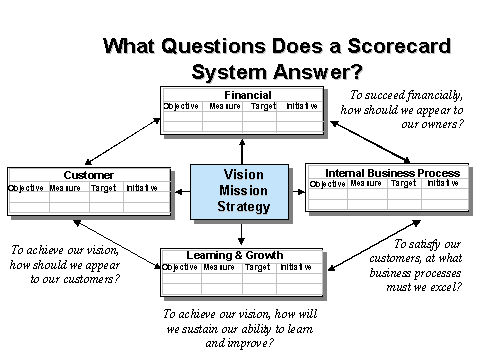
Figure 1: Questions
Measurement Matters: " If you can't measure it, you can't manage it".
If companies are to survive/prosper in the information age they must use measurements and management systems derived from their strategies and capabilities. Unfortunately many organizations espouse strategies about customer relationships, core competencies, and organizational capabilities while motivating and measuring performance only with financial measures.
Financial Perspective
The BSC retains the financial perspective since financial measures are valuable in summarizing the readily measurable economic consequences of actions already taken. They indicate whether a company's strategy, implementation and execution are contributing to the bottom line.
The financial measures tend to be profit related (by operating income), return on capital employed (ROCE or EVA) and Sales growth or generation of cash flow.
Customer Perspective
Identifies the customer and market segment in which the business will compete and measures performance in these targeted segments. The perspective typically includes several core/generic measures like customer satisfaction, customer retention & acquisition and market share. The perspective should also include specific measures of value proposition in the specific market/customer i.e. lead-time, on time delivery if applicable.
Internal Business Process Perspective
The Internal perspective identifies the critical internal processes in which the organization must excel. These processes enable the business to:
- Deliver the value propositions that attract and retain customers
- Satisfy shareholder expectations on financial returns
The internal measures focus on the processes that have the greatest impact on customer satisfaction and financial objectives.
The inclusion of innovation measures in this perspective also gives the organization drivers of long-term financial success as well as short-term operational measures.
Learning & Growth Perspective
Learning and Growth perspective identifies the infrastructure that the organization must build to create long-term growth and improvement. Businesses are unlikely to be able to meet their long-term targets for customers and internal processes using today's technologies and capabilities. Also intense global competition requires companies continually to deliver value to customers and shareholders. Learning and Growth comes from people, systems and organizational procedures.
The financial, customer, and internal perspectives will reveal gaps in the capabilities of people, systems and procedures. To close these gaps businesses will have to invest in re-skilling employees, enhancing IT systems and aligning organizational procedures. Measures include: Employee satisfaction, employee retention, system availability & "front line" customer information, Alignment of employee incentives with overall organization success factors etc..
The best Balanced Score Cards consist of a series of objectives and measures with linkages incorporating both cause-and-effect relationships and a mixture of outcome measures and performance drivers.
Cause-and-Effect Relationships
A strategy is a set of hypotheses about cause and effect. The chain of cause-and- effect should pervade all four perspectives of the Balanced Score Card therefore a properly constructed Balanced Score Card should tell the story of the company's strategy.(figure 2)
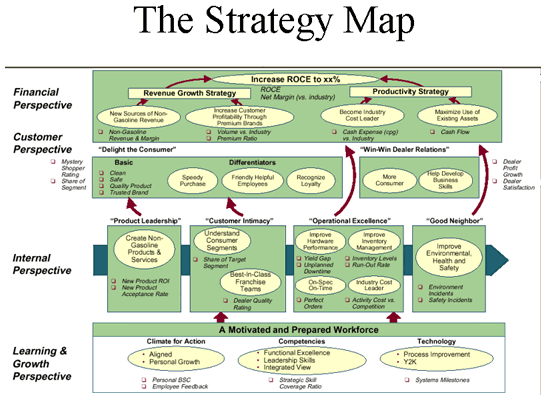
Figure 2: The Strategy Map
Performance Drivers
A good Balanced Score Card should also have a mix of outcome measures (lagging indicators) and performance drivers (leading indicators). Outcome measures without performance drivers do not communicate how the outcomes are to be achieved or give an early indication about whether the strategy is being implemented successfully. Conversely performance drivers without outcome measures (may achieve short term operational improvements) fail to reveal whether operational improvements have translated into expanded business with enhanced financial performance. Example (Figure3)
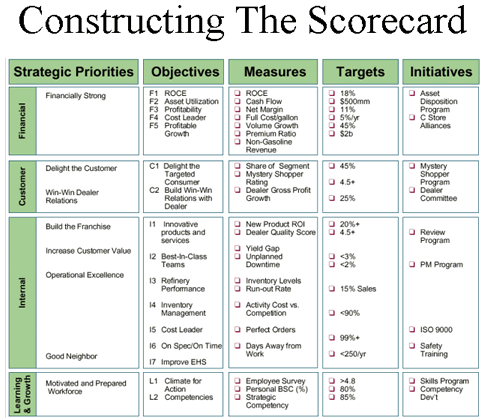
Figure 3: Constructing the Scorecard
A completed organizational score card needs to have the following components:
- Strategic Themes Identified
- Strategic Objectives Identified
- Measures for the execution of the strategic objectives
- Competitive Bench Marks for the measures selected
- Short Term and Long term targets for identified measures
- Initiatives aligned to the Strategic objectives for execution and review.
Once the organizational score card is prepared and finalized the scorecard is to be used as an effective method of alignment see (figure 4). Departmental, Process, and Individual score cards aligned to corporate score card will translate your strategy to daily management.
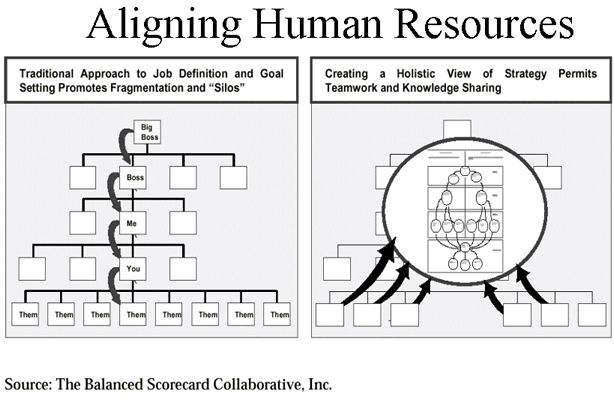
Figure 4: Aligning Human Resources
Links to Six Sigma
Six Sigma is a unique variability reduction management strategy for Business improvement. The most powerful aspect of Six Sigma is in the application of the rigorous DMAIC philosophy to projects to achieve higher customer satisfaction and Business results. While Six Sigma helps organizations in elimination of waste in their pursuit to excellence the Balanced Score Card lays the foundation for the implementation of an effective Six Sigma strategy.
When one attempts to view the evolution of various measurement systems you could see that Balanced Score Card encompasses Financial, Strategic and Operational measurements. See (Figure 5). It is clear to visualize that implementation of Balanced Score Card followed by the deployment of Six Sigma is a better approach towards Six Sigma deployment. While the proven statistical tool set of Six Sigma operates at the operational level the Balanced Score Card provides the rationale for identification of areas for improvement .
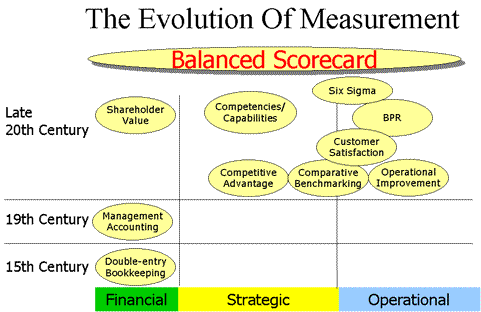
Figure 5: Evolution of Measurement
References:
- Balanced Score Card By Kaplan and Norton.
Author: Shree Phadnis
Published: March 2002
|
Shree Phadnis is a Master Black Belt at KPMG (India). He is an ASQ Certified Six Sigma Black Belt, ASQ Certified Quality Manager and ASQ Certified Quality Engineer.
He can be contacted at e-mail address: shreephadnis@usa.net
or through us at info@symphonytech.com
|
|

 Top
Top